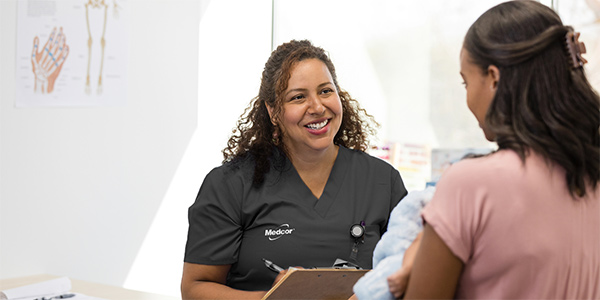10 Questions to Ask Before Choosing an Occupational Health Provider

Choosing an occupational health provider is a decision that directly affects your workforce’s wellbeing, your safety culture and your bottom line. In today’s environment, where healthcare costs are climbing and workplace injuries remain one of the most expensive business risks, selecting the right partner can determine whether your program prevents injuries or simply reacts to them.
The wrong provider may appear cheaper up front, but can cost employers significantly more in the long run through higher claim volumes, longer recovery times and reduced productivity.
1. What Occupational Health Services Do You Offer Beyond the Basics?
Every provider offers injury care. The best go further. Look for partners that deliver comprehensive occupational health, from 24/7 injury triage and onsite clinics to preventative programs like ergonomic training, wellness checks and respirator fit testing.
Providers that can scale services with your workforce, such as adding coverage for a new shift or expanding to satellite sites, reduce downtime and control costs.
2. Can You Tailor Services to Our Industry and Workforce?
No two worksites, or workforces, are alike. A provider that treats construction hazards the same way as office injuries isn’t providing occupational care; they’re providing generic care.
At Medcor, we take great care to ensure the right fit between our clinic staff and each client’s work environment. We don’t deliver “out-of-the-box” services, we customize every program to the employer’s operations, workforce risks and culture. This deliberate alignment helps ensure employees receive relevant, responsive care from clinicians who understand their specific environment.
3. How Experienced Is Your Clinical Team in Occupational Medicine?
Depth of experience matters. Providers specializing in occupational health bring a higher level of expertise in workplace injuries, OSHA compliance and workers’ compensation coordination.
Ask whether clinicians have occupational medicine certifications or experience in similar worksite settings.
Medcor, for example, requires some of its medical professionals to be board certified in occupational medicine depending on their role and experience level. Every clinician completes Medcor’s rigorous occupational health boot camp and ongoing training in evidence-based medicine. Our clinics are staffed by experienced clinicians trained in occupational health protocols supported by proprietary, research-backed systems.
4. How Do You Stay Current on Best Practices and Regulations?
Occupational health isn’t static. Regulations evolve, treatments improve and safety standards change.
Your provider should have formal processes for continuous education and compliance monitoring, covering OSHA updates, provincial or state requirements and workers’ compensation laws, to help you stay compliant and avoid costly fines.
5. What Is Your Approach to Preventing Injuries Before They Happen?
A strong provider does more than treat injuries, they help stop them from occurring.
Ask how they support proactive health and safety, such as:
- Ergonomic and movement assessments
- Early symptom intervention
- Safety training and toolbox talks
- Data-driven injury trend analysis
Prevention saves money, protects workers and strengthens your safety culture.
6. How Do You Manage Emergencies and Offsite Referrals?
Even the best onsite programs will face emergencies. The right provider uses evidence-based navigation to determine when offsite care is needed and where the employee should go.
Providers with 24/7 teletriage ensure incidents are evaluated immediately and routed to the right level of care, avoiding unnecessary ER visits and reducing claims.
7. What Technology Powers Your Occupational Health Program?
Technology should enhance, not complicate, care. Ask about systems that support:
- Secure data management
- Digital injury reporting and OSHA compliance
- Same-day dashboards for KPIs and ROI
- Evidence-based triage protocols
Medcor invented the technology that powers modern occupational health. Our proprietary EHR, purpose-built for employee and occupational health, guides clinicians through every step of the assessment, ensuring consistency and compliance. It also integrates reporting directly into client portal dashboards, giving employers full visibility into their program’s performance.
8. How Do You Measure Success and Share Results?
A credible partner will align outcomes with your business KPIs. Ask how they track and report metrics like:
- Injury rates and trends
- Lost-time and modified-duty cases
- Return-to-work timelines
- Cost avoidance and claim reductions
Transparent data allows you to make informed, measurable improvements.
9. How Do You Protect Employee Privacy and Ensure Compliance?
Trust is essential. Employees must feel confident their information is protected.
Your provider should comply with HIPAA and any regional regulations, using encrypted systems and strict access controls. Secure reporting builds employee trust and shields your organization from liability.
10. How Will You Partner With Us Beyond Clinical Care?
An occupational health provider should act as a strategic partner, not just a vendor. Ask how they integrate with your safety teams, HR and leadership to support culture, compliance and communication.
The right partner helps you:
- Reduce overall healthcare spend
- Improve productivity and retention
- Strengthen mental and physical wellbeing initiatives
- Enhance data visibility and decision-making
Choosing the Right Partner
Selecting the right occupational health provider transforms your health and safety program from reactive to strategic.
At Medcor, we deliver occupational health solutions built for your business, onsite clinics, mobile care units, 24/7 teletriage and integrated injury prevention, all backed by evidence-based medicine and proprietary technology.
Speak with a Medcor advocate to learn how we can help you protect your people, reduce costs and create a safer, healthier workplace.